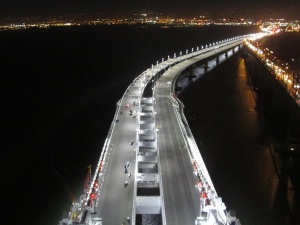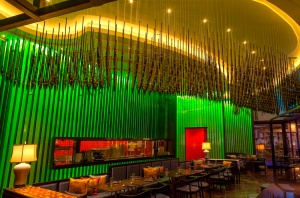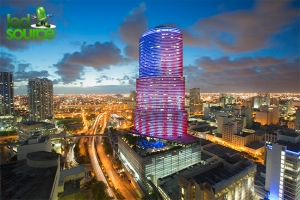Construction Economists Forecast a Surge In 2016

All leading indicators point to a surge in new construction starts in 2016. Does that mean that the recession is finally over? That is still up for debate as we enter a presidential election year and are still dealing with a loss of jobs, high unemployment and of course the extremely high costs associated with socialized medicine.
On the other hand, if you listen to what construction economists are quietly saying, you will hear that there is some light at the end of the tunnel as new construction starts should make some substantial gains in 2016. With the current economic state of affairs in China, I also believe that we will be seeing more companies making business decisions to relocate back to the United States. Interest rates are on the increase domestically, yet we are still struggling with the price of crude oil. I’m not complaining because we are seeing all-time lows in the cost of crude. However, there is ultimately going to be a negative impact on the United States and Canada as long as we continue to depend on OPEC. In my opinion, once we have decided to not pursue our own resources, OPEC will then position itself to implement increases to which we will have no recourse.
The best way to prevent rising energy costs and insulate the U.S. from global price spikes is by actively producing our own American energy resources. This includes more American produced oil, natural gas, coal and nuclear, along with alternative sources such as wind, solar, hydropower and geothermal. Producing more American energy will lower prices, create new American jobs, reduce our dependence on foreign oil, strengthen our national security, and raise new revenue.
Now, back to the current trending of the new construction industry in the United States, Ken Simonson, chief economist for the Associated General Contractors of America is bullish on the market for most types of construction. For example, construction spending increased 14% from September 2014 to September 2015.
According to Robert Murray, chief economist and vice president of Dodge Data & Analytics, “The construction expansion is continuing, and the ongoing increase should result in greater demand for the services of electrical contractors.” If fact, as shown in table 1 below, the economy is expected to grow 3.1% in 2016, and total construction starts are forecast to move upwards by 6% to $712B. Looking at the table, one can see where the current projections are for a 9% increase for non-residential building. Residential is projected to increase by 16%, while the non-building sector will slide by 14%.

Looking at the overall projected health of the construction industry in 2016, most FMI (One of the nation’s leading construction economic & analysis firms) microeconomists are predicting that the total construction put into place will experience a healthy increase of 7%. That includes a 9% jump for residential, a 7% increase for non-residential as well as a 3% shift upwards in non-building (Table 2 below). As previously stated, although single family dwellings are on the upsweep, the multifamily dwellings are going to benefit even more from the construction upswing in 2016. The latest increase by the Federal Reserve is clearly indicative of the bullish market.
The latest economic correction is seeing a much stronger dollar. However, that in turn hurts US exports into those countries that are currently experiencing an economic downward spiral such as China and Europe.
In terms of non-residential markets, the hospitality industry and commercial segments are projected to see gains of 12% and 10% respectfully. This is only for new construction and does not allow for retrofit applications which are projected to experience double digit growth in 2016 in most every segment.

Healthcare is a surprise to me, but is understandable considering several factors such as Obamacare, the rising cost of medical insurance, the loss of medicial jobs, while at the same time, we constinue to be an aging society. Look for that number (4%) to spike into double digits after the presidential election in November. This industry is going to be placed into a position in which it will have no choice other than to increase new construction in 2017.
How does all of this breakdown and what will it mean to you in your region of the country? As the chart below indicates, most every region of the United States with the exception of the South Central States will all share in the uptick of new construction. The South Central portion of the United States is historcially the poorest region and is typically the last to benefit from an economic correction. However, because it is the poorest regional economically, affordable housing is abundant and that region of the country should actually see more growth in residential buildings (both single family dwellings as well as multi-family housing) thank the rest of the nation. The South Atlantic States are positioned to benefit more than any other region of the United States in overall new construction starts.
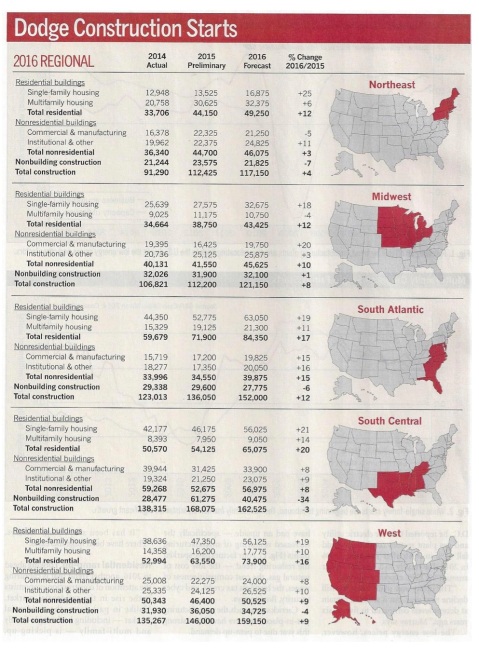
Robert Murray is projecting a somewhat more than modest upswing in US construction activity across all segments. “We saw a pause in the non-residential building market for 2015, but it followed some good percentage gains for construction starts in 2013 (up 11%) and 2014 (up 24%).” “The market fundamentals still remain positive for commercial buildings, and we are still seeing support for the institutional building sector from the passage of numerous bond construction measures in recent years.”
As I eluded to earlier in this report, the retrofit market continues to move forward with tremendous gains in virtually every market segment. The LED replacement lamp market will grow 30% annually, in terms of units sold, between 2012 and 2016 according to new research published by analyst firm Strategies Unlimited.
Strategies Unlimited has published a new report entitled “LED replacement lamp market analysis and forecast” that projects a global LED-retrofit-lamp market that exceeds $3.7 billion by 2016. The growth in solid-state lighting (SSL) products intended for existing sockets is from a $2.2 billion base in 2011, and the firm projects an annual 30% growth in the number of units sold.
According to the report, there were 39.9 million SSL A-lamps (A19 lamps with a legacy Edison base) sold globally in 2011. Strategies Unlimited analyst Katya Evstratyeva said that Japan led the way in consuming LED A-lamps with 24.7 million of the global total. The Japanese Eco-point program was in part responsible for the high market numbers, but Evstratyeva said other factors such as environmental concerns and high prices in compact-fluorescent lamps (CFLs) contributed as well.
Perhaps surprisingly, the market for LED-based linear fluorescent replacement lamps was strong globally as well. Strategies Unlimited reports 19.3 million units sold with 41% of those sales coming in China, 21% in Japan, and only 18% combined in the US and the European Union.
I attribute the lower numbers in the United States to the fact that we are just now beginning to recognize and accept linear LED tubes as a viable and dependable alternative to traditional fluorescent lamps. Further, agencies such as UL & DLC are now listing linear LED tubes as safe and qualified for rebates and incentives. Efficacy levels and L70 data has increased dramatically which is in turn leading to what I believe will be a banner year for this type of retrofit application.
By Tim Hardy, P.E.
Efficient LED Lighting in Restaurants

LED Lighting In Restaurants
An LED, or Light Emitting Diode, is a semiconductor that illuminates when electrical currents passes through it. They are small, yet clustered together with diffuser lenses, which means the application of them can be much wider and commercial. The use of LED lighting in restaurants has many advantages for both business owners and customers alike.
High Efficiency
LED lights are highly efficient especially when compared to traditional lights where 90% of the energy used is lost in heat. LED lamps absorb heat into a heat sink resulting in the majority of power supplied converted into light – no wasted energy.
Many restaurants operate their lighting an average of 12-16 hours per day. Making the switch to LED lighting saves money immediately reducing monthly electricity bills without turning off the lights.
Long Life
LED light bulbs last about 10 to 50 times longer than a traditional light bulbs and have an average lamp life of 25,000 to 50,000 hours – a definite advantage for restaurants. Conventional light bulbs burn out a lot faster, making the investment in LED lighting a sensible idea since you won’t have to replace light bulbs as often.
Durability
Conventional incandescent light bulbs have a slender and fragile fibre called a filament, which can easily break if not handled properly. These light bulbs get very hot, burn out and need to be changed often.
Compact fluorescent bulbs or CFLs use less energy than incandescent bulbs, but they contain mercury and can easily break, causing additional environmental and disposal concerns for restaurant owners.
LED lights are more durable because they don’t have a filament and are less prone to damage or smashing when dropped or bumped. For restaurants, when a traditional light bulb breaks, it can be dangerous for customers and staff. LED lights are less likely to break when dropped and don’t use glass. The days of cleaning up a broken light bulb are gone forever!
Cost Efficient
Conventional light bulbs produce more heat, use more electricity, and are likely to need replacement more often due to short life spans and damages.
LED lighting is more energy-efficient, saving money on your electricity bills. In addition, LEDs produce very little heat which results in lower HVAC costs.
Why Choose LED?
The most popular MR16 halogen light bulb uses 50 watts. It produces a lot of heat, has a short life span and burns out quickly. This means constant replacing, maintenance and added costs.
Instead, choose a high output MR16 LED lamp, which is capable of replacing a 50W halogen. It has brilliant distribution of light, operates around 7W, lasts 40,000 hours, and is dimmable.
A high output PAR38 LED bulb is capable of replacing a 120 watts PAR38 halogen. It is energy-efficient operating at 19W, environmentally friendly, emits very little heat, provides directional light, lasts up to 50,000 hours, is dimmable and no UV or IR radiation.
Typical fluorescent T8 lamp kitchen lights can be replaced with Linear LED T8 Tube lighting. These T8 LED lamps are environmentally friendly – contain no mercury and don’t require hazardous waste disposal. They don’t emit UV or IR, no buzz or flickering, instant on and are glass free – safe for all working conditions.
With all the many benefits of efficient LED lighting in restaurants, isn’t it about time you made the switch. LED lighting provides money-saving solutions that will improve the bottom line for any business. Customers and staff will be more comfortable in a cooler working environment and better light quality means a more inviting environment.
Is It Time To Say Goodbye To The Fluorescent Tube
Does it make sense to replace your existing fluorescent lamps with LED tubes? Of course that answer varies depending on your specific application, hours of operation and type of fluorescent tube being used, but the lines are now blurred with recent advancements in LED lighting.
Let’s take a look at one of the most common types of lights used in commercial settings – the 4-foot T-8 fluorescent lamp. The time has finally come to retire the T8 fluorescent tube with the introduction of the new Philips LED T8 InstantFit lamp.
In the past, fluorescent fixture modifications and code compliance made switching to LED tubes a labor intensive project. However, with the new InstantFit from Philips Lighting, ‘Plug and Play’ has finally arrived with the LED tube.
Suitable for a large range of installations and applications, the InstantFit requires no rewiring in fixtures with electronic ballasts. In fact, installation only takes seconds and no electrician needed. It will even operate along side fluorescent tubes in the same fixture – now that is impressive.
InstantFit T8 LED Tube Benefits:
- 40,000 hour lifetime and 4 year warranty!
- No Ballast Bypass – You do not have to touch the ballast at all.
- Mercury Free – Environmentally friendly and requires no costly disposal fees.
- Instant On – No flickering or buzz
- Dimmable & Controllable – Add occupancy sensors to improve the energy savings.
Philips LED T8 InstantFit Tube is now available and shipping in 3500K, 4000K and 5000K color temperatures making it the right choice for all types of general lighting applications.
Related Articles – Is Fluorescent Lighting Causing Havoc In The Workplace?
Bye Bye 75W Incandescent Light Bulb – Phase-out Continues
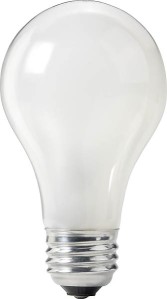 The start of 2013 marked another year closer to the ultimate demise of the Incandescent light bulb in the U.S. and around the world. So what has changed since the U.S. Congress passed legislation in 2007 to ban the bulb that Thomas Edison created? The reason for the Act was to eliminate inefficient energy sources like the incandescent bulb and slowly phase-out the various high-wattage bulb types.
The start of 2013 marked another year closer to the ultimate demise of the Incandescent light bulb in the U.S. and around the world. So what has changed since the U.S. Congress passed legislation in 2007 to ban the bulb that Thomas Edison created? The reason for the Act was to eliminate inefficient energy sources like the incandescent bulb and slowly phase-out the various high-wattage bulb types.
The Energy Independence and Security Act set the stage in 2012 for the banning of the 100-watt incandescent bulb. While this was not enforced since funding was pulled for the Department of Energy (DOE) to police, manufacturers quickly implemented their own program to ultimately stop production. So bye-bye 100-watt bulb.
Fast-forward to 2013 and what is the next plan in the common light bulb phase-out? Say goodbye to the 75-watt bulb as of January 1st and then followed by the 60-watt and 40-watt bulb in 2014.
What is the big problem with conventional incandescent bulbs? While they provide more than adequate lighting for each of us to light our homes, they are highly inefficient. An average of 90% of the energy used to light the bulb is converted into heat, hence the reason it is on the list. Their life span is also a problem when compared to other lighting sources.
The Act mandates that all light bulbs are requiring 25% greater efficiency by 2014. The second part of the law states that by 2020 all light bulbs must be 60-70% more efficient than bulbs used in 2007 and produce a minimum of 45 lumens per watt. Some compact fluorescent (CFLs) and most light-emitting diodes (LEDs) meet these requirements today, shaving energy usage by as much as 75-85%.
There are some exceptions regarding light bulbs being banned in the Act – appliance bulbs, colored lights, plant lights and 3-way bulbs are exempt, as well as light bulbs currently less than 40-watts.
Was the incandescent bulb the only one being phased out? The answer is No. Some fluorescent lights like the T8 and T12 are also on the list. Read more here.
So why did the United States pass this legislation? The goal is to move the Country towards greater energy independence and security, increase the production of clean renewable fuels and improve energy performance while increasing the efficiency of products.
 By now you have heard the entire buzz around LED lighting and consumers are starting to take notice of the benefits, efficiency and the longevity related to this state-of-the-art technology. On average LEDs use 75% less energy, last 15 times longer than incandescent bulbs, instantly turn on, are dimmable, produce little to no heat, perform well outdoors and in cold temperatures and are extremely durable. Many LED Lamps (the word ‘Bulb’ is not commonly referred to for LED Lamps) are Energy-Star Rated and contain no toxic chemicals or gases, unlike CFLs. It is as easy as taking out the existing 100-watt or 75-watt light bulb and screwing in an LED replacement.
By now you have heard the entire buzz around LED lighting and consumers are starting to take notice of the benefits, efficiency and the longevity related to this state-of-the-art technology. On average LEDs use 75% less energy, last 15 times longer than incandescent bulbs, instantly turn on, are dimmable, produce little to no heat, perform well outdoors and in cold temperatures and are extremely durable. Many LED Lamps (the word ‘Bulb’ is not commonly referred to for LED Lamps) are Energy-Star Rated and contain no toxic chemicals or gases, unlike CFLs. It is as easy as taking out the existing 100-watt or 75-watt light bulb and screwing in an LED replacement.
The stage is now set for LED lighting to dominate the marketplace. It is estimated that by 2020 over 60% of general lighting will be LED. Isn’t it time you made the switch to LED lighting?
Related articles
- U.S. Bids Farewell to the 75-Watt Incandescent Light Bulb (greatenergychallengeblog.com)
- It’s lights out for 75 watt light bulbs (wtvm.com)
- More Restrictions On Light Bulbs To Go Into Effect Soon (pittsburgh.cbslocal.com)
LED Lighting Versatility and Flexibility
As I started in the LED lighting industry, one of the things that really excited me is how energy-efficient and long-lasting LED lamps and fixtures are. While that is still very important, I continue to be amazed by the many other benefits of LED lighting. In certain environments such as retail, having the right lighting can make the difference of products selling or not. When I have compared LED lighting against traditional fixtures, the versatility and flexibility makes it the perfect choice for most applications. Now imagine using LED products where you wouldn’t normally think lighting, in the traditional sense, could be used.
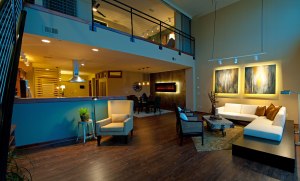 Accent lighting with LED tape light is common, but the way you approach it can be unique. Working with an interior designer at Interior Trends Inc. (ITI) here in Wichita, we used LED tape lighting to create the effect of ‘floating’ panels. They had an electronic fireplace, two pieces of art and a headboard – all would be ‘floating’ off of the wall by several inches. They wanted an accent light behind those panels to enhance the effect. LED tape lighting was used because of its ability to be in tight spaces. It was cost-effective and provided just a subtle amount of light to create the perfect ‘glow’ around the panels and created the effect of floating. An added bonus is that since it is all low-voltage, all they had to do was plug a transformer into a receptacle and attach some simple plug-and-play connectors.
Accent lighting with LED tape light is common, but the way you approach it can be unique. Working with an interior designer at Interior Trends Inc. (ITI) here in Wichita, we used LED tape lighting to create the effect of ‘floating’ panels. They had an electronic fireplace, two pieces of art and a headboard – all would be ‘floating’ off of the wall by several inches. They wanted an accent light behind those panels to enhance the effect. LED tape lighting was used because of its ability to be in tight spaces. It was cost-effective and provided just a subtle amount of light to create the perfect ‘glow’ around the panels and created the effect of floating. An added bonus is that since it is all low-voltage, all they had to do was plug a transformer into a receptacle and attach some simple plug-and-play connectors.
 What about using LED tape lighting to create a ‘crown-molding effect? On a recent project, a client built a small cove near the top of the room and the LED tape light made a beautiful angle of light around the entire room. Simple, elegant and cost-effective, but more importantly, the effect was striking.
What about using LED tape lighting to create a ‘crown-molding effect? On a recent project, a client built a small cove near the top of the room and the LED tape light made a beautiful angle of light around the entire room. Simple, elegant and cost-effective, but more importantly, the effect was striking.
At LED Source®, we have a passion in challenging traditional thinking in the lighting industry. We believe that by doing that, we can bring the greatest value to our clients! Sometimes that can be as complex as engineering a complete solution for an entire facility or as simple and elegant as using a slick little product like LED tape light.
Travis Hettenbach is the owner of the LED Source® Wichita franchise.
Upgrade Your Gas Station To LED Lighting
 If you are the owner of a gas station, then the daily maintenance of your business is priority. Making sure garbage cans are not over flowing, lighting fixtures are working and fuel pumps are functioning, is a daily routine. Aside from convenience, fuel prices and necessity, do you know why some motorists choose to stop at your gas station and why others do not? Could it be your lighting? Should you upgrade your gas station to LED lighting? In most major metropolitan areas, you can usually find a gas station within a 5-mile radius and pass several stations on your daily commute. Knowing the factors that can influence a customer’s decision to visit your gas station can seriously impact the bottom line and affect the growth of your business.
If you are the owner of a gas station, then the daily maintenance of your business is priority. Making sure garbage cans are not over flowing, lighting fixtures are working and fuel pumps are functioning, is a daily routine. Aside from convenience, fuel prices and necessity, do you know why some motorists choose to stop at your gas station and why others do not? Could it be your lighting? Should you upgrade your gas station to LED lighting? In most major metropolitan areas, you can usually find a gas station within a 5-mile radius and pass several stations on your daily commute. Knowing the factors that can influence a customer’s decision to visit your gas station can seriously impact the bottom line and affect the growth of your business.
One of the main factors is your lighting. After sunset, take a look at your gas station from across the street and ask yourself “Does my lighting draw the attention of passing motorists. Does it make them feel safe?” If your answer is “No,” then you may want to consider upgrading your gas station to LED lighting. For the past 10 years, most gas stations that operate 24 hours a day use expensive High Intensity Discharge (HID) fixtures for the lights in the canopy. HIDs consume 175W to 400W of energy, but lose lumen output over time while utilizing the same amount of power. In other words, they are a waste of money and energy for less performance. HIDs also require a ballast, which means more maintenance for you. Once you factor in the costs of replacing a broken fixture (labor and lift rental), daily energy usage and maintenance, it’s easy to see how HID lights have an expensive cost-of-ownership.
Now fast forward to 2012 and imagine an LED fixture that uses 80% less energy, lasts 20X longer, reduces maintenance, emits virtually no heat and comes with a warranty of up to 5 years. Allow me to introduce you to the next generation of gas station lighting – LEDs. Over the past several years LED lighting technology has been replacing traditional lighting fixtures and lamps because they last longer, save energy, illuminate brighter and require less maintenance than halogen, incandescent, fluorescent and metal halide lighting.
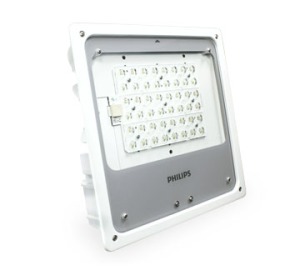 Phillips innovative Mini 300 LED under canopy fixture is a retrofit solution for gas station owners looking to upgrade their existing fixtures without major modifications. This LED fixture can replace a 400W metal halide fixture, consumes only 110W, can be dimmed to 30% and last over 100,000 hours. Phillips estimates a Return On Investment (ROI) of less than 4 years and depending on where your gas station is located, you could qualify for an energy rebate from your local utility company, thus reducing the cost of upgrading and ownership. If you’re still unsure about making the switch to LEDs, consult with a gas station LED lighting EXPERT at LED Source®.
Phillips innovative Mini 300 LED under canopy fixture is a retrofit solution for gas station owners looking to upgrade their existing fixtures without major modifications. This LED fixture can replace a 400W metal halide fixture, consumes only 110W, can be dimmed to 30% and last over 100,000 hours. Phillips estimates a Return On Investment (ROI) of less than 4 years and depending on where your gas station is located, you could qualify for an energy rebate from your local utility company, thus reducing the cost of upgrading and ownership. If you’re still unsure about making the switch to LEDs, consult with a gas station LED lighting EXPERT at LED Source®.
Occupancy Sensors: A Good Idea?
Is installing occupancy sensors a good idea? Conditionally, yes. So you’re thinking, what are the conditions? Keep reading and I promise to let you know.
 Let’s take a look at how occupancy sensors can save you money and have a positive impact on the environment. I’m sure we’ve all heard our parents tell us while growing up, TURN OFF THE LIGHTS! Sorry about the shouting, but that’s how I heard it when I grew up. As we got older and started paying our electric bills (for our homes and businesses) we started to understand that turning off unused lights would save us money. That’s exactly what occupancy sensors do; they turn off the lights when not needed and turn the lights on when they are needed. No more wasted light means no more wasted energy, no excess burned coal! Woohoo, you’re saving money on your lighting and producing fewer carbon dioxide emissions.
Let’s take a look at how occupancy sensors can save you money and have a positive impact on the environment. I’m sure we’ve all heard our parents tell us while growing up, TURN OFF THE LIGHTS! Sorry about the shouting, but that’s how I heard it when I grew up. As we got older and started paying our electric bills (for our homes and businesses) we started to understand that turning off unused lights would save us money. That’s exactly what occupancy sensors do; they turn off the lights when not needed and turn the lights on when they are needed. No more wasted light means no more wasted energy, no excess burned coal! Woohoo, you’re saving money on your lighting and producing fewer carbon dioxide emissions.
This sounds like a great idea and by this point you may be wondering why I’ve chosen to put all of these words to digital paper. I’m about to let you know.
 In keeping with saving money, let’s say you’ve decided to put your money saving occupancy sensors on compact fluorescent and fluorescent lamps. Wow, now you’re really saving money with those efficient lights. Right? Well, maybe not so much. As you may know, frequent power cycling shortens the life of compact fluorescent and fluorescent lamps. Uhh, what? Turning the lights on and off repeatedly will drastically reduce the life of your CFL and Fluorescent lamps. This means the energy savings you thought you were getting are now being eaten up by lamp replacement. Now you have to recycle your burned out, mercury filled, CFL’s and buy new ones on a much shorter time line than the “10,000” hour life span.
In keeping with saving money, let’s say you’ve decided to put your money saving occupancy sensors on compact fluorescent and fluorescent lamps. Wow, now you’re really saving money with those efficient lights. Right? Well, maybe not so much. As you may know, frequent power cycling shortens the life of compact fluorescent and fluorescent lamps. Uhh, what? Turning the lights on and off repeatedly will drastically reduce the life of your CFL and Fluorescent lamps. This means the energy savings you thought you were getting are now being eaten up by lamp replacement. Now you have to recycle your burned out, mercury filled, CFL’s and buy new ones on a much shorter time line than the “10,000” hour life span.
True story: A coffee shop owner installed an occupancy sensor in the bathroom with compact fluorescent lamps. The CFL’s were being replaced once a month due to the high on/off cycling. They were paying $4 per lamp and there were 3 lamps, so $12 per month wasted on mercury filled light. I’m sure you’ve already guessed the solution; that’s right, LED lamps. The life of an LED is not affected by frequent on/off cycling. This means, the energy savings you are looking for will not be wasted on lamp replacement! Add the even longer life and lower energy usage and what do you have? A truly cost efficient solution!
So yes, occupancy sensors are a good idea when attached to the right lighting technology and yes you guessed it…LED lighting.
For more information contact the LED lighting experts at LED Source or call 866-900-4533.
Switch Your T12 Fluorescents To LEDs Before It’s Too Late
 We get tons of inquiries here about people looking to replace their old, worn out or dead lights with the new, latest and greatest LEDs. Sometimes it’s for cosmetic reasons, sometimes it’s to save money, and sometimes it’s to go green. If you currently have T12 fluorescent fixtures in your space, you can accomplish all 3 goals in one fell swoop.
We get tons of inquiries here about people looking to replace their old, worn out or dead lights with the new, latest and greatest LEDs. Sometimes it’s for cosmetic reasons, sometimes it’s to save money, and sometimes it’s to go green. If you currently have T12 fluorescent fixtures in your space, you can accomplish all 3 goals in one fell swoop.
LED Source® carries multiple lines of 1×4, 2×2 and 2×4 LED fluorescent fixture replacements. We have several excellent options from Cree. They are the CR14, CR22 and CR24 respectively. They come in a very attractive package and at a very attractive price. Check out the picture, look how sharp that fixture looks. Go one, check it out, I’ll wait. Not only is it a looker but lasts longer and that saves you money. The LED lamp will last over 13 years if you use it 12 hours a day. T12 lamps claim to last almost 3 years at that amount of usage, but we all know that they’re very dim if they make it that long and usually burn out well before that from the on/off cycling they undergo. That doesn’t even take into account replacing the ballasts in your system every few years. Add up the costs of the parts and labor to do that and you’re looking at a significant maintenance cost. Plus, T12 lamps are going to be phased out as early as late 2012 and won’t even be available!
Not only do you save on lamp and ballast replacement costs, but you will also save on your electrical bill every month. The typical T12, 4 lamp fixture uses 172 Watts of power between the lamps and ballast. The Cree CR24 equivalent uses only 50 Watts. So, not only are you saving money and time not having to replace components, but you are also using 71% less energy per fixture. That’s significant savings on just a few fixtures; imagine if you have hundreds or thousands of these in your facility what the savings would be.
And finally, if you’re looking to go green, LED is the lighting solution for you. They are mercury free (all fluorescent lamps have mercury in them and must be specially disposed of), recyclable and don’t contain the dangerous chemicals that are in other types of lighting. With the combination of easy maintenance, cost savings and excellent good looks, there is no better solution on the planet than to replace your fluorescent lighting with LED fixtures from LED Source®.
Give LED Source® a call today at 866.900.4533 and speak with one of our LED lighting experts.




